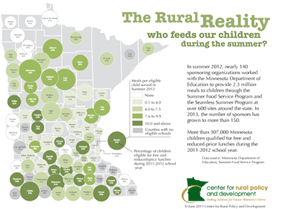Who Feeds Our Children During the Summer Months?
June 6, 2013
School bells across the state are ringing out the last days of the academic year. For most children, the last day of school marks the beginning of the carefree days of summer. For too many families – especially in rural Minnesota – the last day of school is also the first day of scrambling to replace the meals their children receive at school.
Hunger isn’t just an urban issue. While Ramsey is the only one of the 11 Twin Cities metro counties with more than half of the children eligible for free and reduced-price school lunches, 13 rural counties topped the 50-percent mark during the 2011-12 school year. In almost all other rural counties, more than 30 percent of the children are eligible for free and reduced-price school lunches.
A new infographic – an illustrated fact sheet – compiled by the Center for Rural Policy and Development highlights the breadth of the challenge hunger creates during the summer months.
Last summer, nearly 140 sponsoring organizations worked with the Minnesota Department of Education to provide 2.3 million meals to children through the Summer Food Service Program and the Seamless Summer Program at over 600 sites around the state. In 2013, the number of sponsors has increased to more than 150.
In Greater Minnesota, though, organizers of the summer food programs face five challenges that can be particularly difficult for rural families, according to CRPD:
- Transportation: The high cost of gas and the limited availability of public transportation pose particular challenges to rural Minnesotans. Second Harvest Heartland awards grants to sponsors to help increase participation, including assisting with non-food expenses like transportation and activities.
- Rural Minnesota’s sparse population: The sparse population and greater distances in rural areas make getting kids and volunteers to meal sites more of a challenge.
- Availability of sponsors: Rural areas have fewer organizations to act as sponsors for summer food programs compared to the more urban metro areas of the state. Sponsors are asked to provide the food, the site and the volunteers. The Minnesota Department of Education reimburses sponsors for food expenses.
- Awareness: Getting word out to parents and kids about opportunities for meal sites and activities is difficult, especially with fewer mass media outlets serving rural Minnesotans.
- Stigma: Some families may be reluctant to have their neighbors find out that their children qualify for free or reduced-price lunches at school. Most sites are open to all children, however, regardless of income, and no proof of eligibility is needed.
“Programs that make it possible for kids to have nutritious meals year-round are critical to raising healthy kids,” said Brad Finstad, executive director of the Center for Rural Policy and Development. “The investment we make in summer food programs will see a return many times over in young people who are able to thrive and grow into healthy, productive adults.”
To download a pdf of the infographic, click here.
For more information from the Minnesota Department of Education, call (651) 582-8526 or email mde.fns@state.mn.us.
For more information from Second Harvest Heartland, contact Sara Blair at sblair@2harvest.org org or (651) 484-5117.



